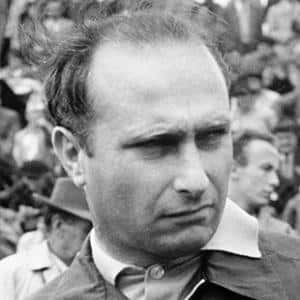‘Colourful, glamorous and exciting’ — Sir Jackie Stewart on racing in the 1950s
It was the time of heroes such as Moss, Fangio and Ascari, drivers who were redefining what it meant to be a racer and in the crowd a young Sir Jackie Stewart felt the first stirrings of desire to follow suit. Here he explains the intoxicating attraction of 1950s motor sport
Getty Images
I had an enormous enthusiasm and interest for motor sport when I was growing up in the 1950s. And even though my own competitive focus was on Olympic trapshooting for much of the decade, it was in many ways a formative time for my subsequent racing career; it set the tone.

My brother Jim Stewart, or Jimmy as he was known, drove for Ecurie Ecosse, Jaguar and Aston Martin. He raced mostly in sports cars but he did drive some single-seaters too. I remember as a 14-year-old watching him at Silverstone in the British Grand Prix in 1953; he was going well, running as high as sixth for Ecurie Ecosse in a Cooper-Bristol when with a few laps to go he had a shunt at Stowe corner. He would have finished fifth that day without the crash.
“All any driver can be is the best of his era and Fangio was that”
After that he raced for Aston Martin at the Le Mans 24 Hours in 1954 but he had an accident and was thrown from his DB3S – his arm was badly broken. He injured the same arm in 1955 following a crash in the Nürburgring 1000Kms driving for Ecurie Ecosse – and that’s when he decided it was time to retire.
It was Jimmy who took me to a lot of races – seldom abroad, mainly in the UK because Ecurie Ecosse were just a great Scottish team, but it meant I came into contact with many of the top names of that era. I got my autograph book filled by the likes of Alberto Ascari, Stirling Moss of course, Louis Chiron, George Abecassis and the great Juan Manuel Fangio.
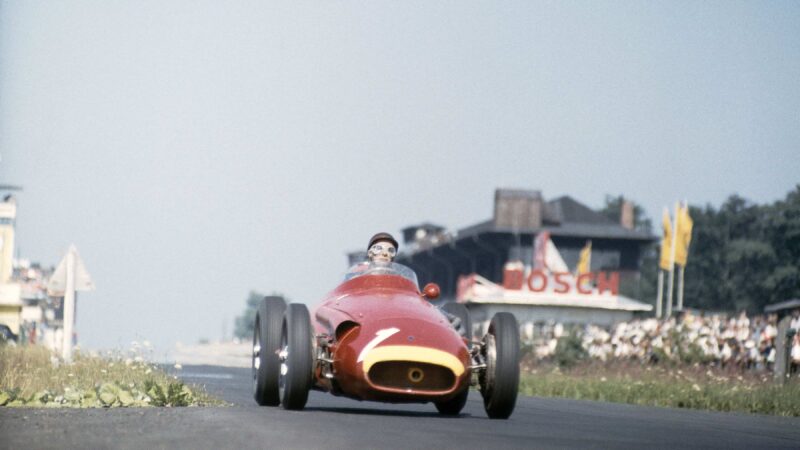
Fangio, a hero of Sir Jackie’s, way out at the front of the 1957 German GP, held at the Nürburgring. It would be his final F1 win and one of his finest
Getty Images
Fangio was the maestro of our sport. The man won five world championships with four different constructors: Alfa Romeo in 1951, Mercedes-Benz in 1954 and 1955, Ferrari in 1956 and Maserati in 1957.
People have always debated the greatest racing driver of all time. In my view all any driver can be is the best of his era and Fangio was certainly that, but his manner outside the cockpit took him to a different level. Some say that he was competing in a less-demanding age when there were fewer cars on the grid and fewer races in the calendar but I do not accept that passing time can in any way detract from his achievement. For example, he was no athlete by modern standards of physical conditioning and yet it is a fact that he was able to produce incredible performances in searing temperatures and sapping humidity. On many occasions, when other drivers were retiring or collapsing through heat exhaustion Fangio remained on the track winning with apparent effortless ease.
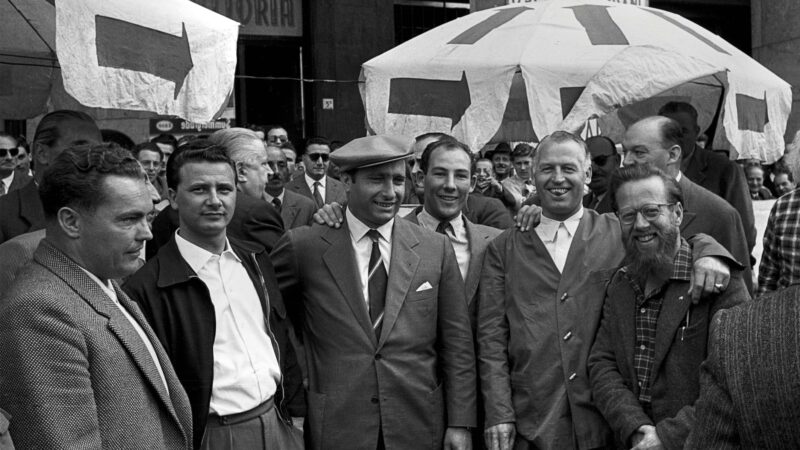
Motor Sport’s Jenks, right, at the Mille Miglia, 1955 – in illustrious company including Hans Herrmann, Fangio, Moss and Karl Kling
Getty Images
Fangio was my hero when I was young and he was undoubtedly the best of his era. However, the sport has changed so much over the years that it is impossible to compare him alongside multiple world champions such as Jack Brabham, Niki Lauda, Alain Prost and Ayrton Senna. Many of these changes have been for the better and F1 appears to be thriving today. The sport is safer than it was in my day, and what was once a gentleman’s sport has become a highly efficient and effective business – although I daresay many will mourn the passing of the private entrants motivated more by a real passion for motor sport than by the opportunity to add a few noughts to their bank balance.
Years later in 1964, at the F3 support race in Monaco, things came full circle thanks to an incident that occurred soon after the finish. My delight at winning turned to wonder when I looked up and realised that a thick-set, relaxed and instantly recognisable man from Argentina was walking towards me. It was Juan Manuel Fangio, the greatest driver of all time, and he had clearly made his way down from the balcony from where he had been watching the race in the company of Prince Rainier.
Escorted by his friend, the photographer Bernard Cahier, the great man smiled and shook me by the hand. He spoke in Spanish in quite a high-pitched almost squeaky voice his eyes darting between me and his translator.
“Well driven, young man,” he said. “That was very impressive.” You take the compliments from whom they come and without wanting to exaggerate the significance of this incident, in the context of my career I believe this moment – having won my first race abroad, as a 25-year-old driver standing in the pitlane and being congratulated by the great Fangio, a man whom I had idolised for as long as I could remember and whose autograph I had collected at Silverstone 11 years before – ranks as one of the most cherished experiences of my life.
If Fangio was the greatest of his era, then Jim Clark was the best driver I ever raced against. I first met Jimmy in July 1958 in the evening after the hillclimb at Rest And Be Thankful. The much-heralded young driver had competed in the event and stopped for petrol at our garage in Dumbuck on his way home. Jim Clark stepped out of his car and on to our forecourt wearing, I recall, a blue roundneck sweater and grey flannels. The pundits were talking about him as a star of the future and I had read all about him in the various motor sport magazines at the time – ‘the comics’ as I called them. I knew his family were farmers in the Borders, I knew he had started his racing career in cars provided by Ian Scott-Watson and I knew he was a member of the Border Reivers racing team run by Jock McBain. And here he was visiting our garage.
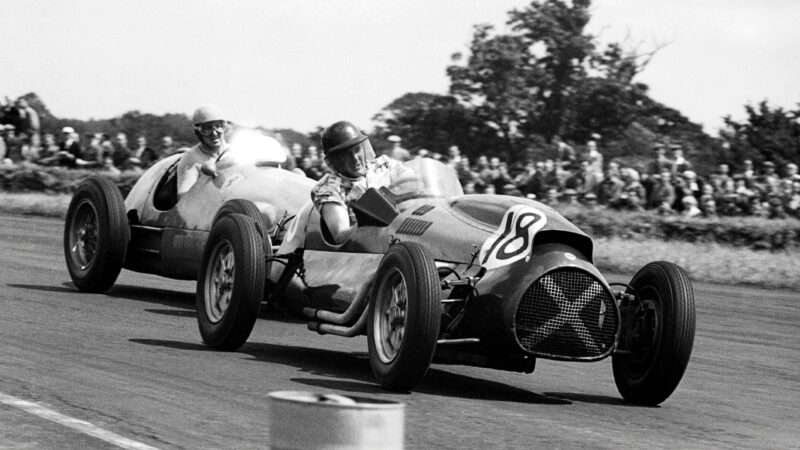
Sir Jackie’s elder brother Jimmy was on the grid of the 1953 British GP, racing the No18 Cooper
Getty Images
I continued to follow his career, once standing in the crowd at Oulton Park and watching him dominate a Formula Junior race, right through to 1961 when he signed with Colin Chapman and Lotus and became a Formula 1 driver.
When I started racing, we always seemed to get along and during my club racing career and throughout my first three seasons in F1 this humble, unaffected genius became my benchmark and role model. Just his presence at an event somehow seemed to make me more relaxed and as a result more successful.
I learnt something very important from those early experiences – small things as well as large. For example Stirling Moss was another one of my heroes. One of the reasons for that is when you got Stirling Moss’s autograph you could read it, because it was always clear and brisk in how he wrote it. Never mind the quality of his driving, which was fantastic! I learnt from that and to this day I make sure my autograph is clear – although I get asked for selfies more than autographs these days! To get home and not be able to read an autograph was one of the most frustrating things.
The great names that were involved in the 1950s during my younger days still resonate. Of course Ferrari, but also Vanwall and Mercedes-Benz. David Murray of Ecurie Ecosse was a remarkable man, to win Le Mans twice in successive years – 1956 and ’57 – with a privately entered car. I didn’t get to Le Mans on those occasions, but I did get there eventually in the Rover-BRM gas turbine with Graham Hill in 1965, the only such car that ever did the 24 Hours.
I feel very privileged that I had these experiences as part of my life as a young enthusiast. Motor racing was colourful, glamorous and exciting. That’s what drew me to it. It was the sight of a racing car, particularly the sound of a Formula 1 car – and the people. The characters were different then. We travelled together, we holidayed together, we were close – not just for ourselves but for our wives and girlfriends, who were all characters too. Of course motor racing was ridiculously dangerous. Helen and I counted once: we lost more than 60 friends.
“The characters were different then. We travelled together, holidayed together, we were close”
I’m not one to say the past was the best, but the camaraderie was better because we were in each other’s company so much. Jimmy Clark, Graham Hill and Jochen Rindt were among my best friends. We drove everything, even when we were at the top of our profession: saloon cars, sports car, F2, IndyCar as well as F1. That’s different to today. Denny Hulme and I used to travel to Can-Am races together – always in economy, by the way! We learnt silly things, like how to get out of a circuit at the end of a race because you’ve got to get back to England. What’s the fastest way? Most people would say with a police escort – but the best one is in an ambulance! But you’d rush to be in the front, because no one wanted to be in the back of an ambulance! These small things we learnt together created a depth of friendship that doesn’t happen today.
And Motor Sport was a part of that scene and my life. I have a collection of them that I’ve kept. This lovely magazine will be in my mind forever because it documented my enthusiasm for motor racing, first through my brother Jimmy and then through my own life.
Motor Sport had some of the best journalists there has ever been in motor racing, although of course Denis Jenkinson was very much against me because I was challenging motor sport for being overly dangerous and aspired for a better level of safety. He didn’t approve of that and we fell out. He was very outspoken. But at the same time he knew I was driving reasonably well. When I won at the Nürburgring in 1968 for Ken Tyrrell by more than four minutes he gave me credit for that. That meant something to me.
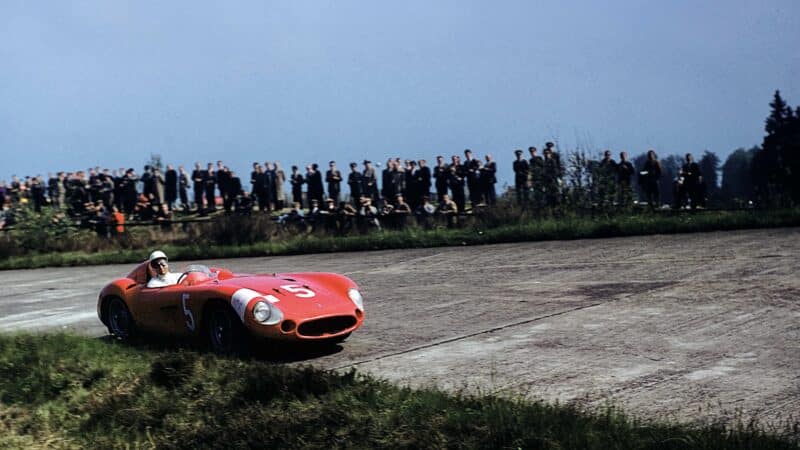
One of Maserati’s greatest days, with Moss setting the pace in the 1956 Nürburgring 1000Kms
Getty Images
I think those early years were also crucial in creating a racing heritage for Britain. Drivers like Stirling Moss – whom I so revered as the epitome of an exciting modern racing driver, a man who walked and talked in the way I thought a racing driver should; and Mike Hawthorn who raced wearing a bow-tie beneath his overalls.
Then there are the team owners, principals and designers from that era. John Cooper who together with his father Charles was the originator of the rear-engined racing car in the UK and built the car that Jack Brabham drove to victory over Ferrari in 1959 and 1960. That success created demand for what became the most-advanced small-batch engineering industry in the world.
Colin Chapman arrived and through his achievements with Lotus became probably the most brilliant and innovative design engineer and constructor in the history of the sport. Eric Broadley was up there too, the wonderful creator of Lola Cars which became the largest producer of racing machinery in the world at one time. There are others. But for so many reasons the 1950s truly was a defining decade.
